Tourist Attractions and
places to visit in Aswan:
Back
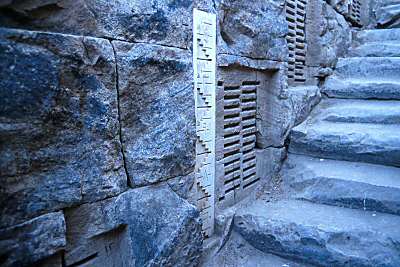 Elephantine
Island:
Elephantine
Island, just outside the centre of Aswan, is one of the
highlights of Egyptian nature. Dark yellow stones, where green
trees grow out of nothing, framed by the sky that's always blue,
and the Nile, even more blue. Elephantine Island housed a
sizable Jewish community some 400-500 years BCE, but it remains
an enigma what happened to them. On the other side of the Nile,
the western, you can see the Aga Khan mausoleum, which is very
new, but has it's charm through being the shrine over the
celebrity-imam dying in 1957. And it's one of the few landmarks
in the nearest vicinity of Aswan.
Elephantine
Island:
Elephantine
Island, just outside the centre of Aswan, is one of the
highlights of Egyptian nature. Dark yellow stones, where green
trees grow out of nothing, framed by the sky that's always blue,
and the Nile, even more blue. Elephantine Island housed a
sizable Jewish community some 400-500 years BCE, but it remains
an enigma what happened to them. On the other side of the Nile,
the western, you can see the Aga Khan mausoleum, which is very
new, but has it's charm through being the shrine over the
celebrity-imam dying in 1957. And it's one of the few landmarks
in the nearest vicinity of Aswan.
Known to the Ancient
Egyptians as Abu or Yebu, Elephantine stands at
the border between Egypt and Nubia. It was a natural
transshipping point for river trade, and, as an island, also
provided an excellent defensive site for a city. According to
Egyptian mythology, here was the dwelling place of Khnum, the
ram-headed god of the cataracts, who controlled the waters of
the Nile from caves beneath the island: he was worshipped here
as part of a Triad comprising him, his wife Satis, and their
daughter Anuket. There are records of a temple to Khnum here as
early as the third dynasty, and most of the southern tip of the
island is taken up by the ruins of the later temple to him that
was completely rebuilt in the Late Period (30th dynasty).
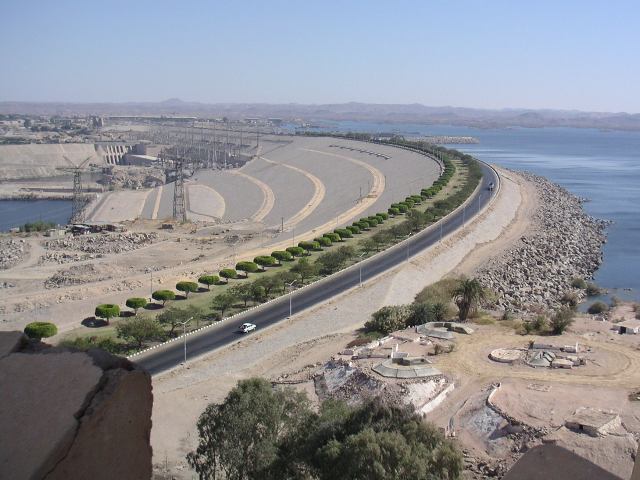 The
High Dam: Located near Aswan, the world famous High Dam
was an engineering miracle when it was built in the 1960s. It
contains 18 times the material used in the Great Pyramid of
Cheops. The Dam is 11,811 feet long, 3215 feet thick at the
base and and 364 feet tall. Today it provides irrigation and
electricity for the whole of Egypt and, together with the old
Aswan Dam built by the British between 1898 and 1902`, 6km down
river, wonderful views for visitors. From the top of the two
Mile long High Dam you can gaze across Lake Nassar, the huge
reservoir created when it was built, to Kalabsha temple in the
south and the huge power station to the north.
The
High Dam: Located near Aswan, the world famous High Dam
was an engineering miracle when it was built in the 1960s. It
contains 18 times the material used in the Great Pyramid of
Cheops. The Dam is 11,811 feet long, 3215 feet thick at the
base and and 364 feet tall. Today it provides irrigation and
electricity for the whole of Egypt and, together with the old
Aswan Dam built by the British between 1898 and 1902`, 6km down
river, wonderful views for visitors. From the top of the two
Mile long High Dam you can gaze across Lake Nassar, the huge
reservoir created when it was built, to Kalabsha temple in the
south and the huge power station to the north.
The Unfinished
Obelisk: The Unfinished Obelisk located in the Northern
Quarry
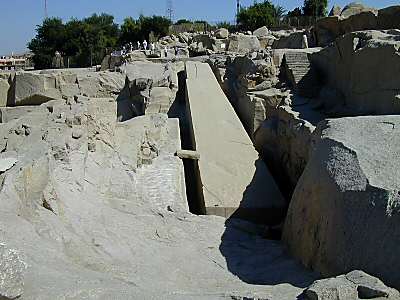 still
lies where a crack was discovered as it was being hewn from the
rock. Possibly intended as a companion to the Lateran Obelisk,
originally at Karnak but now in Rome, it would have weighed over
2.3 million pounds and would have been the worlds largest piece
of stone ever handled. However, a crack in the stone occurred,
which caused it to be abandoned. Tools left by it's builders
have given us much insight into how such work was performed. The
site has recently been renovated and equipped with tourist
facilities. Nearby is the Fatimid Cemetery.
still
lies where a crack was discovered as it was being hewn from the
rock. Possibly intended as a companion to the Lateran Obelisk,
originally at Karnak but now in Rome, it would have weighed over
2.3 million pounds and would have been the worlds largest piece
of stone ever handled. However, a crack in the stone occurred,
which caused it to be abandoned. Tools left by it's builders
have given us much insight into how such work was performed. The
site has recently been renovated and equipped with tourist
facilities. Nearby is the Fatimid Cemetery.
Tha Agha Khan
Tomb (Symbol of Love):
The Aga Khan was
extremely wealthy. On his birthday in 1945, he was weighed in
diamonds which he then distributed to his followers. It should
be noted, also, that he was a large man. Every day that his
widow was at the Villa, she places a Red Rose on his white
Carrara marble tomb. His widow, Omme Habibeh, popularly referred
to as "The Begum" died on July 1st, 2000. The other months, a
gardener fills this function, and it has been rumored that at
one point, not a single rose could be found in Egypt, so for
almost a week, roses were flown in from Paris by private jet.
Mohammed Shah Aga Khan was educated in Europe and succeeded his
father in 1885 to become the 48th imam. He was succeeded by his
grandson, Karim AGa Khan upon his death in 1957.
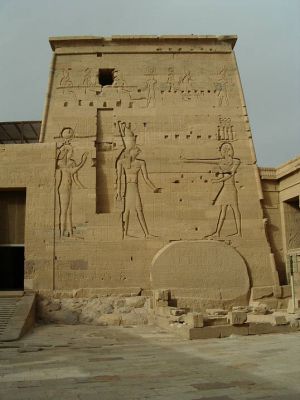 The
Philae temple (Isis Temple): On a small island in the
Nile near Aswan stands the amazing Temple of Isis at Philae.
This monument is possibly best known for the international
effort which moved it in it's entirety to the island when it's
original location was threatened by the change in water level
caused by the High Dam.
The
Philae temple (Isis Temple): On a small island in the
Nile near Aswan stands the amazing Temple of Isis at Philae.
This monument is possibly best known for the international
effort which moved it in it's entirety to the island when it's
original location was threatened by the change in water level
caused by the High Dam.
Philae Temple was
dismantled and reassembled (on Agilika Island about 550 meters
from its original home on Philae Island) in the wake of the High
Dam. The temple, dedicated to the goddess Isis, is in a
beautiful setting which has been landscaped to match its
original site. It's various shrines and sanctuaries, which
include The Vestibule of Nectanebos I which is used as the
entrance to the island, the Temple of the Emperor Hadrian, a
Temple of Hathor, Trajan's Kiosk (Pharaohs Bed), a birth house
and two
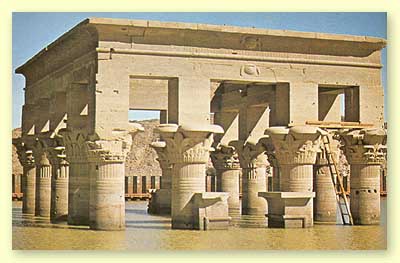 pylons
celebrate all the deities involved in the Isis and Osiris myth.
The Victorian world fell in love with the romance of the Temple.
But at night you can also visit the Sound and Light Show, a
magical experience as floodlit buildings are silhouetted against
the volcanic rocks and water surrounding them. So today, Philae
is more fun than ever before.
pylons
celebrate all the deities involved in the Isis and Osiris myth.
The Victorian world fell in love with the romance of the Temple.
But at night you can also visit the Sound and Light Show, a
magical experience as floodlit buildings are silhouetted against
the volcanic rocks and water surrounding them. So today, Philae
is more fun than ever before.
